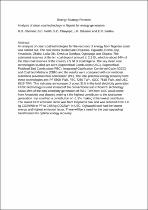JavaScript is disabled for your browser. Some features of this site may not work without it.
- ResearchSpace
- →
- Research Publications/Outputs
- →
- Journal Articles
- →
- View Item
| dc.contributor.author |
Oboirien, BO

|
|
| dc.contributor.author |
North, Brian C

|
|
| dc.contributor.author |
Obayopo, SO

|
|
| dc.contributor.author |
Odusote, JK

|
|
| dc.contributor.author |
Sadiku, ER

|
|
| dc.date.accessioned | 2019-03-13T09:21:09Z | |
| dc.date.available | 2019-03-13T09:21:09Z | |
| dc.date.issued | 2018-04 | |
| dc.identifier.citation | Oboirien, B.O., North, B.C., Obayopo, S.O., Odusote, J.K., Sadiku, E.R. 2018. Analysis of clean coal technology in Nigeria for energy generation. Energy Strategy Reviews, v.20, pp 64-70. | en_US |
| dc.identifier.issn | 2211-467X | |
| dc.identifier.uri | https://www.sciencedirect.com/science/article/pii/S2211467X18300026 | |
| dc.identifier.uri | http://hdl.handle.net/10204/10797 | |
| dc.description | Copyright: 2018 Elsevier. Due to copyright restrictions, the attached PDF file only contains the abstract of the full text item. For access to the full text item, kindly consult the publisher's website | en_US |
| dc.description.abstract | An analysis of clean coal technologies for the recovery of energy from Nigerian coals was carried out. The coal mines studied are Onyeama, Ogwashi, Ezimo, Inyi, Amasiodo, Okaba, Lafia-Obi, Owukpa Owukpa, Ogboyoga and Okpara. The estimated reserves of the ten coal deposit amount to 2.1 Gt, which is about 84% of the total coal reserves of the country 2.5 Gt of coal Nigeria. The key clean coal technologies studied are Ultra-Supercritical Combustion (USC), Supercritical-Fluidised Bed Combustion (FBC), Integrated Gasification Combined Cycle (IGCC) and Coal bed Methane (CBM) and the results were compared with conventional subcritical pulverised fuel combustion (PF). The total potential energy recovery from these technologies are: PF 5800 TWh, FBC 7250 TWh, IGCC 7618 TWh, and USC 8519 TWh. This indicates an increase of about 31% in the total electricity generation if USC technology is used instead of the conventional sub-critical PF technology. About 39% of the total electricity generation of 8519 TWh from USC could come from Amasiodo coal deposit, making it the highest contributor to the total power generation. Inyi coal had a contribution of ~1.5% making it the lowest contributor. The lowest CO(sub)2 emission factor was from Onyeama coal and was reduced from 1.0 kg CO(sub)2/kWh in PF to 0.68 kg CO(sub)2/kWh in USC. Oghwashi coal had the lowest energy and highest emission factor. There will be a need for the coal upgrading/ beneficiation for optimal energy recovery. | en_US |
| dc.language.iso | en | en_US |
| dc.publisher | Elsevier | en_US |
| dc.relation.ispartofseries | Worklist;20536 | |
| dc.title | Analysis of clean coal technology in Nigeria for energy generation | en_US |
| dc.type | Article | en_US |
| dc.identifier.apacitation | Oboirien, B., North, B. C., Obayopo, S., Odusote, J., & Sadiku, E. (2018). Analysis of clean coal technology in Nigeria for energy generation. http://hdl.handle.net/10204/10797 | en_ZA |
| dc.identifier.chicagocitation | Oboirien, BO, Brian C North, SO Obayopo, JK Odusote, and ER Sadiku "Analysis of clean coal technology in Nigeria for energy generation." (2018) http://hdl.handle.net/10204/10797 | en_ZA |
| dc.identifier.vancouvercitation | Oboirien B, North BC, Obayopo S, Odusote J, Sadiku E. Analysis of clean coal technology in Nigeria for energy generation. 2018; http://hdl.handle.net/10204/10797. | en_ZA |
| dc.identifier.ris | TY - Article AU - Oboirien, BO AU - North, Brian C AU - Obayopo, SO AU - Odusote, JK AU - Sadiku, ER AB - An analysis of clean coal technologies for the recovery of energy from Nigerian coals was carried out. The coal mines studied are Onyeama, Ogwashi, Ezimo, Inyi, Amasiodo, Okaba, Lafia-Obi, Owukpa Owukpa, Ogboyoga and Okpara. The estimated reserves of the ten coal deposit amount to 2.1 Gt, which is about 84% of the total coal reserves of the country 2.5 Gt of coal Nigeria. The key clean coal technologies studied are Ultra-Supercritical Combustion (USC), Supercritical-Fluidised Bed Combustion (FBC), Integrated Gasification Combined Cycle (IGCC) and Coal bed Methane (CBM) and the results were compared with conventional subcritical pulverised fuel combustion (PF). The total potential energy recovery from these technologies are: PF 5800 TWh, FBC 7250 TWh, IGCC 7618 TWh, and USC 8519 TWh. This indicates an increase of about 31% in the total electricity generation if USC technology is used instead of the conventional sub-critical PF technology. About 39% of the total electricity generation of 8519 TWh from USC could come from Amasiodo coal deposit, making it the highest contributor to the total power generation. Inyi coal had a contribution of ~1.5% making it the lowest contributor. The lowest CO(sub)2 emission factor was from Onyeama coal and was reduced from 1.0 kg CO(sub)2/kWh in PF to 0.68 kg CO(sub)2/kWh in USC. Oghwashi coal had the lowest energy and highest emission factor. There will be a need for the coal upgrading/ beneficiation for optimal energy recovery. DA - 2018-04 DB - ResearchSpace DP - CSIR LK - https://researchspace.csir.co.za PY - 2018 SM - 2211-467X T1 - Analysis of clean coal technology in Nigeria for energy generation TI - Analysis of clean coal technology in Nigeria for energy generation UR - http://hdl.handle.net/10204/10797 ER - | en_ZA |






